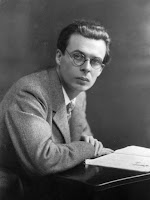Aldous Huxley's well known books are The Doors of Perception and Brave New World, I was drawn to the fact that he experimented with psychedelic drugs and visionary experiences as research for his work. So I wanted to focus on the details behind The Doors of Perception.
- Mescaline is the drug he found most effective for research, it comes from Peyote which is a psychedelic cactus, also known as the San Pedro cactus.
- Native Americans used to use Peyote for religious ceremonies, it would be used to simulate visions of prophecies, healing and inner strength.
- The drug has no physical or unpleasant mental side effects.
- It is illegal when in the drug form but Huxley would often contemplate weather it should be seen as a drug or a research chemical.
Huxley was always interested in spiritual matters and had used alternative methods for a while. But hypnosis, autohypnosis and meditation weren't producing the effects he wanted. A statement that he made that I really like was "Drugs are a toxic shortcut to self transcendence". In the 1950's he had an attack of a bad eye condition called Iritis, this had a massive impact on his sight, could this have had a lot to do with his urge to experiment with different states of conciseness and mental states that alters the way you see. I think this could have made him more susceptible to visions and become more in sync with the metaphysical world.
- Humphry Osmond was a psychiatrist and the guy that provided/introduced Huxley with the mescaline, and would sometimes observe whilst Huxley was on the drug for his own research.
- Humphy Osmond was the creator of the word psychedelic!
- Huxley had a friend called Gerald Heard that would take psychedelics with him and experience vision in spiritual way.
YouTube Videos:
The doors of perception:
https://www.youtube.com/watch?v=mbI4f1WvN9w
This video is an over view of The Doors of Perception, and is basically Huxley talking about the details of his mescaline experience. He talks about having enhanced vision and how vibrant and colourful the flowers looked. He had an inkling of what its like to be insane. He says "there is no time, no space, everything is what we have proposed to ourselves". The experiences took place outside of time. They left him in a state of euphoria that lasted for months. He mentions about the experiences being a good way to investigate and understand yourself.
The mescaline experiment: Humphry Osmond & Christopher Mayhew:
https://www.youtube.com/watch?v=Hd4rgyZzseY
I found this video of a Humphy Osmond experiment with someone called Christopher Mayhew. You see him on the drugs and how he reacts to them, he is asked different questions and asked to explain his visuals to see how it effects his brain. I found it really interesting, I could tell just by watching how intense and uncontrollable thoughts where projected into his head, and how his thoughts would wonder off on there own and he would lose connection to the physical world slightly.
Drawing Huxley:
- The round glasses.
- His hair, how it is swept back and sticks out behind his ears.
- His smart clothing.
- His almost triangular shaped face that could be exaggerated.
I sketched his face out quickly to figure out the shapes and gestures I could use for his caricature. His nose was tricky because I tend to draw noses in a similar way all the time. I observed his nose closely until I managed to get shapes I could work with.
I tried to visualise some of the things I had learnt about Huxley, (on the right) Is trying to explain about how he would investigate himself using the drug. The reflection in the mirror would represent an 'elevated' version of himself during the hallucination. And the action of looking in the mirror would suggest him observing himself.
I tried applying some abstract lines and shape to suggest changing his consciousness, and also give motion and action to the portrait to show that something is happening. I put a door in the head of the character, this could be an interesting way to show how the drugs would access his brain and alter his perception. This would link the designs nicely to his book 'The Doors of Perception'.








No comments:
Post a Comment